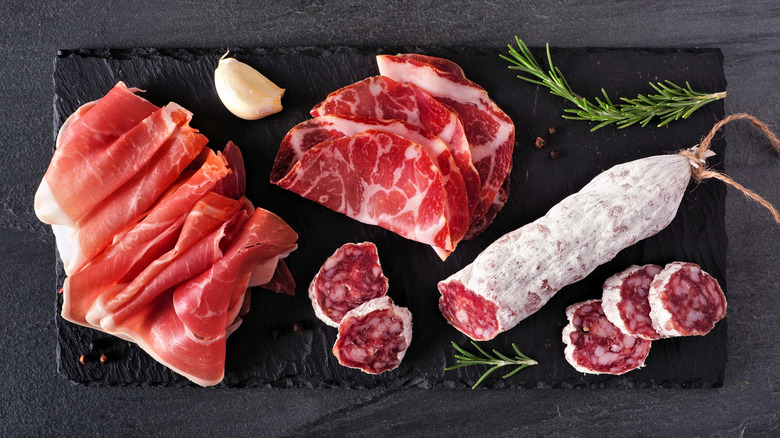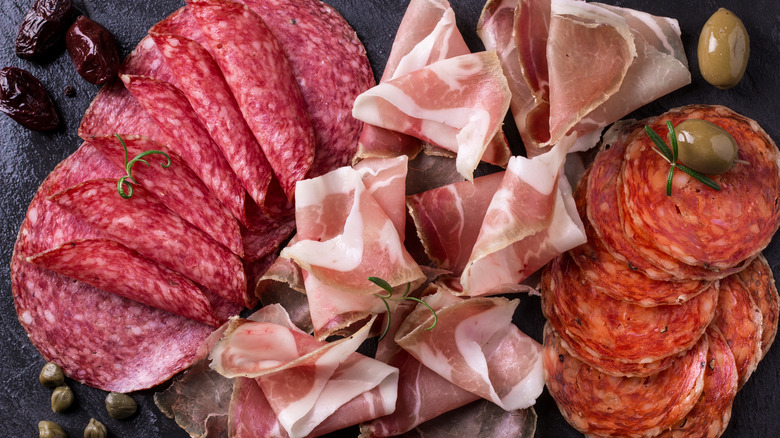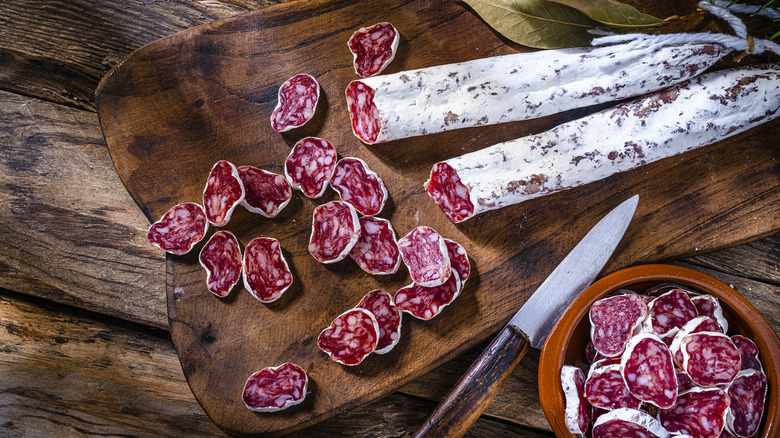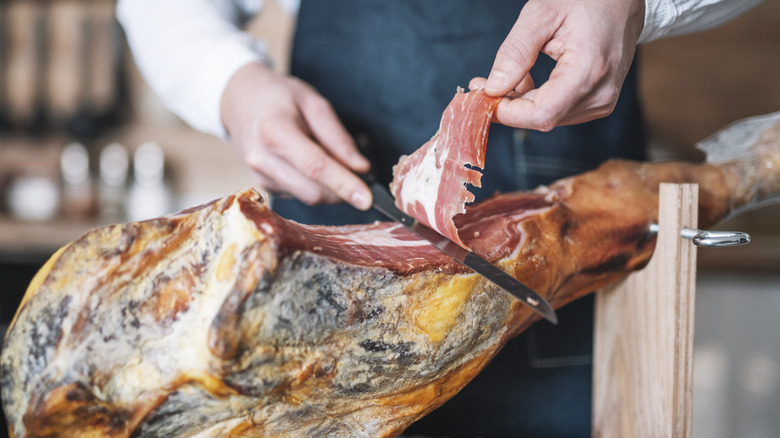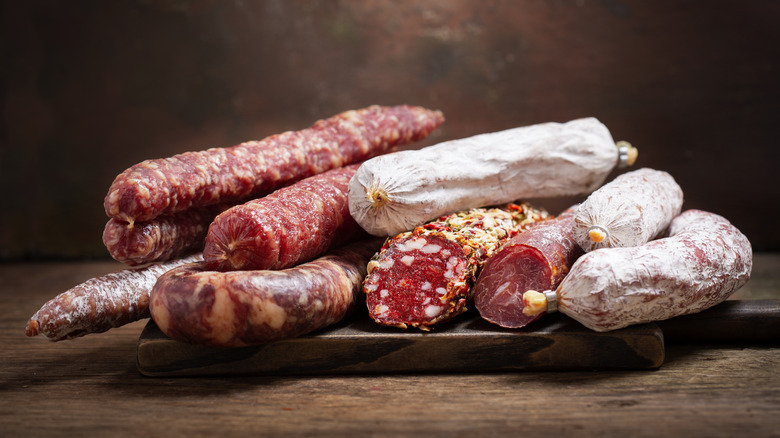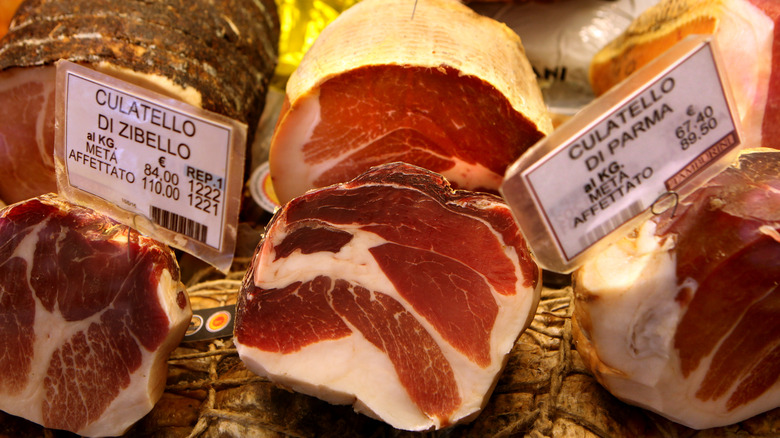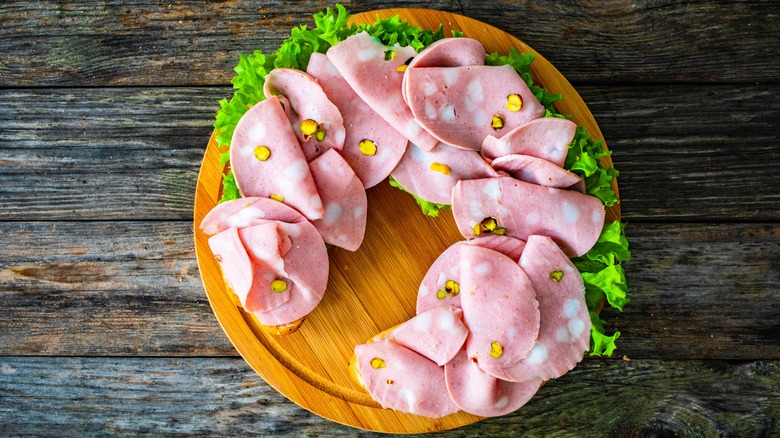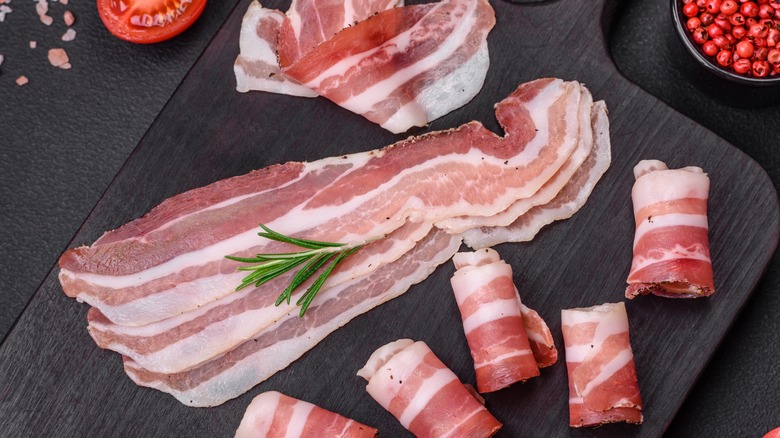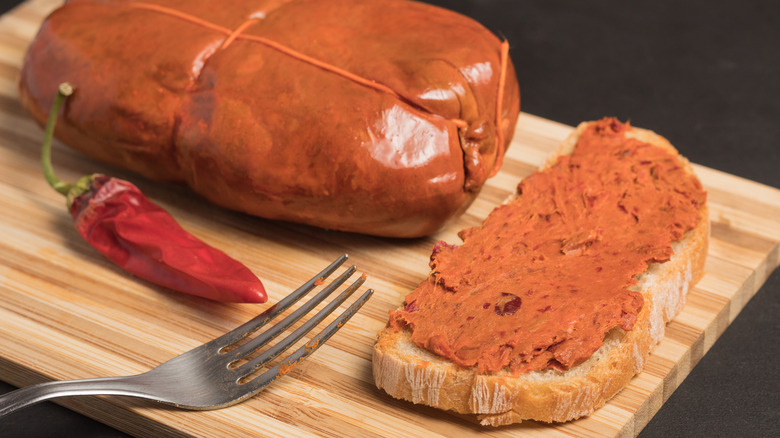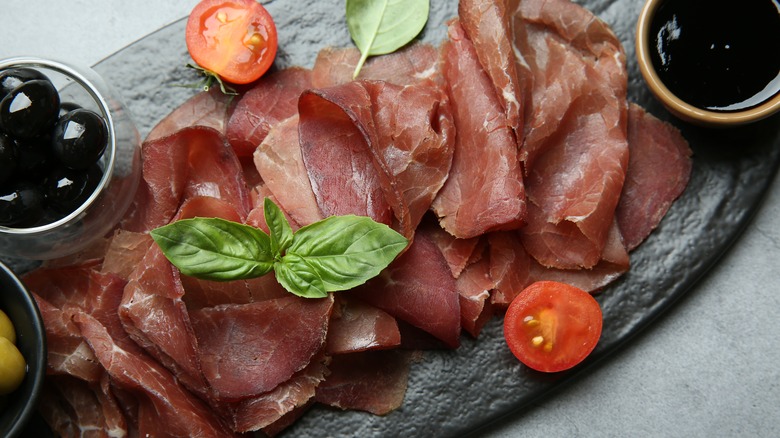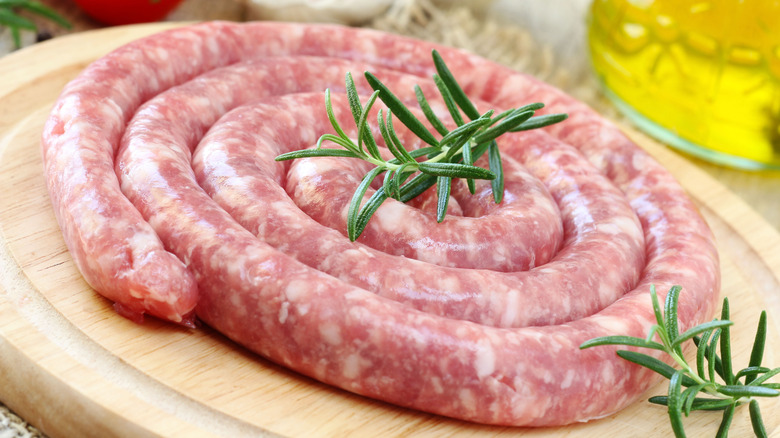The Difference Between Salami And Salumi Is More Than Just One Letter
A luscious spread of Italian cured meats can conjure a couple of different images. In one vision, maybe you are in the Italian countryside where your table runneth over with fine prosciutto, mortadella, and soppressata, plus some cheeses and wine for good measure. In the other, perhaps you are Tony Soprano, deep in the heart of Taylor ham country in New Jersey. Your bathrobe is open and you're hunched over the refrigerator, blissfully digging through the wax paper folds of a package of gabagool.
Now, as to which vision speaks to your soul, we won't judge. What we can help with, however, is breaking down the contents of those dreamy, meaty treats. Are they salumi or salami, and what exactly is the difference? The words are sometimes used interchangeably, but don't let the similar spelling fool you. Salumi — or salume, in the singular — is the Italian term for the region's tradition of cured meat, typically that made from pork. Salami, whose interior is ground or chopped, is a subcategory of salumi. There are countless types of salumi and the more narrowly defined salami alike.
Salumi is an umbrella term for Italian cured meats
To best understand what we talk about when we talk about salumi, it is helpful to look at similar terms across Europe. We can consider salumi as the Italian equivalent to charcuterie in France or delikatessen in Germany — ready-to-eat meat products steeped in regional tradition.
Indeed, the urge to cure meat in order to create a shelf-stable product is universal and ancient. Cave paintings in Sicily indicate that humans were curing meat as far back as 40,000 BCE, at which time they would have used sea salt or ash from plants. Meat can be cured in a number of ways, including via salting, brining, canning, drying, or aging. The curing process discourages bacterial growth, and it is also key to salumi's deeply flavorful, concentrated taste — particularly among dried salumi. "When meat is dry-cured, it loses 30% of its weight in water; like a stock reduced by one-third, meat reduced by a third is rich, dense, and intensely flavorful," write Michael Ruhlman and Brian Polcyn in their book "Salumi: The Craft of Italian Dry Curing."
Across almost all of these processes, salt is a central ingredient, as it absorbs the moisture in which bacteria would otherwise thrive ("prosciutto" comes from the Latin word "perexsuctum," which means "to dry"). For bigger cuts of meat, salt is frequently injected into the flesh to further prevent the formation of bacteria. In some instances, nitrates are added as an extra form of protection.
Salami is one subcategory of salumi
In the wide world of salumi, salami is a universe unto itself. Salami is a dried sausage, meaning it has the same makeup as that beloved category of meat in tubed form. Salamis are made of forcemeat — a blend of meat, offal, fat, and seasonings — and stuffed into casings. Typical additional ingredients include wine, garlic, herbs, peppercorns, fennel, and chilies.
Natural casings made of pig or lamb intestines are the most common and have been for thousands of years, but some are made from inedible cellulose — as frequently seen with pepperoni and bologna — or edible collagen. Some salami casings are inoculated with penicillium nalgiovense, resulting in their characteristic white exterior. The mold protects the meat from bad mold, keeps it moist, and provides a distinct, funky flavor. The look has become so associated with high-end salami making that some producers use imitation mold like rice or milk powder.
Unlike other kinds of sausage, salami has an especially long shelf life as a result of its being dried and fermented. According to the USDA, unopened hard or dry sausages can last for six weeks without refrigeration. The naturally warm environs of Southern Italy (as well as France and other warm-weather regions of Europe) became a hotbed for salami production, owing to the forgiving climate. Other types of salami, including mortadella, are cooked rather than cured, resulting in a less aggressively salty taste.
The other salumi subcategory is whole-muscle
While salami exists within the confines of casing, whole-muscle products — the other major category of salumi — are kept intact. They're made up of whole cuts of an animal, usually pig, and come from a few main muscles: the leg, jowl, belly, shoulder, and loin (otherwise known as the back).
These muscle groups are cured in salt for several weeks. The excess salt is then removed, followed by another extended period of drying at a controlled temperature. The curing process differs depending on the type of salumi. Prosciutto is coated with a layer of lard to keep the leg from drying out too much. Though the seasonings are not as fully incorporated as they might be in a forcemeat, whole-muscle salumi can still be seasoned with spices like pepper and coriander, as well as with wine.
Most types of salumi — with the exception of varieties like guanciale and pancetta — are best enjoyed raw, either on their own or in a sandwich. Their shelf life, however, is shortened once they're sliced, and the thickness of those slices comes down to the consumer.
There are hundreds of hard salami varieties
Within the broad subcategory of salami, it is estimated that there are between 300 and 600 varieties of hard salami. Of those hundreds of options, a few have emerged as the most well-known in North America. A supermarket staple, Genoa salami originated — where else — in the Genoa region of Italy. Genoa is among the softer salami varieties and is seasoned simply with salt, pepper, and garlic. For even more of a zesty, peppercorn-forward bite, consider Felino salami, which is known as "the king of salami."
Another essential and accessible option is soppressata, the spicy version of which is flecked with fiery bites of Calabrian red pepper flakes. Soppressata can be cured for as long as three years, resulting in an especially chewy bite. While Calabrian salami leans spicier, flavors are milder up north in Tuscany, the home of finocchiona. One of Tuscany's oldest salamis, finocchiona gets its distinct flavor from fennel. According to legend, fennel — which grew in abundance in Tuscany — was used in place of the more expensive pepper. One type of finocchiona, sbriciolona, is fresher and crumblier than its firm counterpart.
In the United States, no salami is more famous than pepperoni, the cupped discs of which greasily adorn slices of pizza. If you order a pepperoni pizza in Italy, however, you'll be greeted with a pizza topped with roasted sweet peppers, per the Italian translation. For the fatty pucks of pork, try asking for salami picante.
Delicious salumi comes from the pork leg, neck, and shoulder
Whole-muscle salume can be divided by different muscle groups. Prosciutto comes from the pork leg and is aged between one and three years. Europe runs a tight ship when it comes to prosciutto production, and the Consorzio del Prosciutto di Parma comprises 150 Parma Ham producers who adhere to the European Union's quality control regulations.
Most prosciutto varieties — prosciutto di Parma and prosciutto di San Daniele, for example — are named after the regions in which they are made. Different regions' prosciuttos use different seasonings, and changes in altitude and terroir can affect the taste of the final product. Popular prosciuttos are sold as "crudo," or raw, but other varieties, like prosciutto cotto more closely resemble cooked ham. There are other cuts in the leg that are similar to prosciutto, including the coveted culatello di Zibello, which is soaked in dry white wine for several days.
Speck also comes from the pork leg, and it hails from the snowy mountain region of northeast Italy. As such, it incorporates alpine flavors like juniper berries, bay leaves, and light smoke. Coppa, also known as capicola and, yes, gabagool, comes from the back of the neck and shoulder of the pig. Coppa is roughly 30% fat and 70% lean, resulting in an unctuous mouthfeel, and the taste differs depending where it is produced. In Piacenza, coppa is zhuzhed up with cloves, nutmeg, and cinnamon. In Calabria, the region's titular chilies are added.
Mortadella is similar to bologna
In a sea of hard, dried salami, mortadella stands in a league of its own. While most salami is known for its discrete pockets of meat and fat, the contents of mortadella are emulsified into a homogenous paste, much like hot dogs or bologna, before being stuffed into casings and cooked. It should come as no surprise that mortadella hails from Bologna, Italy, where regulations for production were decreed by the Cardinal Legate in 1661. Then, mortadella was broken down with a mortar and pestle to give tough cuts of meat a pleasing texture.
Mortadella is simultaneously known for its smooth texture and speckled appearance, which is flecked with pieces of pork fat and pistachio. The mild flavor is lifted with pepper and other flavors that can include myrtle berries and coriander.
In the early 20th century, mortadella became a cheap canned product thanks to industrialization, furthering the salume's association with spam and other highly processed deli meats. But the tide has begun to turn on mortadella. In the United States, it has become a coveted nose-to-tail item along with more luxe salumi, appearing on trendy menus and in viral TikToks. Hell, you can even buy mortadella merch in the form of towels, t-shirts, and wall prints. Exports of mortadella to the United States measured 786 tons in 2019. In 2022, that number jumped to 1,200.
Fatty salumi is a common ingredient for cooking
One of the charms of salumi is that it is edible with little to no preparation thanks to the curing and drying process rendering it safe to eat. But, just as you wouldn't want to take a bite out of a gummy, uncooked piece of bacon, some varieties of salumi work better as a cooking ingredient. Those that work better cooked are referred to as culinary salumi against the more grab-and-go friendly snacking salumi.
One culinary salume is pancetta, which is often considered the bacon of Italy. Pancetta is cured pork belly and shares the same lip-smacking saltiness as other salumi, but it isn't smoked like bacon. That said, it is often used as a bacon substitute in cooking, with cubed and rendered pancetta adding a savory bite to soups, stews, pastas, and roasted vegetables. The fatty cut can be enjoyed raw when it's thinly sliced.
Guanciale is similarly fatty, making it excellent for cooking, and comes from pig jowls. Guanciale is an essential ingredient in classic Roman pastas like carbonara and amatriciana. High fat content, however, doesn't mean a salume must be cooked. One caveat is lardo, the spiced and cured fatback that is best enjoyed on a warm piece of bread.
Some salamis are spreadable
Some salumi are fattier than others, and the same goes for salami. It is 'nduja's high fat content that gives it its characteristic, spreadable consistency. For the sake of comparison, dry-cured salami is usually three parts lean meat to one part fat; 'nduja is three parts fat to one part lean meat. 'Nduja, then, was in some ways the ultimate peasant salumi due to its ability to stretch out scraps and offal.
'Nduja hails from Spilinga in Calabria. The region's Calabrian chilies are a key ingredient, and a single 'nduja sausage can comprise up to 30% chilies by weight, resulting in the product's fiery red color. Traditionally, the sausage is packed into a hefty section of the pig's large intestine called the orba before aging for between one and seven months. In the United States, 'nduja is typically sold in smaller, more consumer-friendly collagen casings or even in jars.
Owing to its high fat content, 'nduja exists somewhere between a sausage and a condiment. It can be spread on a sandwich like other salty meat products, or it can be dabbed into tomato sauce, pasta sauces, or onto pizza. It is also easy to mix 'nduja into other creamy ingredients, such as ricotta or polenta.
Bresaola is a popular non-pork salumi
Though most whole-muscle salumi are made of pork, bresaola is the most popular exception. Typically made from beef (though sometimes made of venison or horse), bresaola is less salty than its porcine counterparts and has a bit more delicate sweetness. It is also incredibly lean; before curing and air-drying, the muscle is stripped of any fat. In addition to its comparatively milder flavor, bresaola is also known for its robust, red color that's devoid of any marbling.
Bresaola comes from the alpine Valtellina valley in the Lombardy region of Northern Italy, which is not far from the Swiss border. As such, it's similar to Swiss dishes like Bündnerfleisch and Viande des Grisons. Given how lean bresaola is, the salume benefits from some olive oil and is frequently served with a glug of oil, lemon juice, and some peppery greens.
Bresaola isn't the only non-pork salumi on the market. Other varieties are typically made from duck and wild game. Salami is especially amenable to alternative proteins, with goose, duck, and boar serving as common substitutes for or additions to pork. Bison, elk, and venison can all be treated as whole-muscle salumi, and duck prosciutto — made from the breast rather than the thigh — is a unique take on the classic that is easy enough to make at home.
Do raw sausages count as salumi?
As we have discussed, salami is a diverse and vibrant subgroup of salume. But, can raw sausages be considered salumi? Not exactly. For many producers, the distinction comes down to the curing process. True salumi is a ready-to-eat product, even if some, like guanciale and pancetta, benefit from some cooking. Sausages are essentially nascent salami — raw, encased meat that has yet to be cured, smoked, or cooked. Consider raw versus cured chorizo. Only the latter would be considered a salami (albeit a Spanish-style one).
In addition to salumi, Italy has a rich tradition of sausage-making, the spoils of which are known as salsicce. The variety of fresh Italian sausage is more diverse than the two American options — hot Italian and sweet Italian — would have you believe. Luganega is a mild sausage from Northern Italy that is served as one long coil and is often seasoned with fennel. Pisto is a soft sausage from Lombardy flavored with wine and pancetta.
The Emilian cotechino is also a soft variety, owing to the incorporation of lard and pork rind. Cotechino is traditionally eaten on New Year's Eve, when it is slow cooked with lentils until it begins to break down. Like their cured counterparts, a few fresh sausages have earned the regional distinction of PDO (Protected Designation of Origin) or PGI (Protected Geographical Indication) certification.

